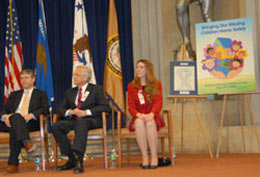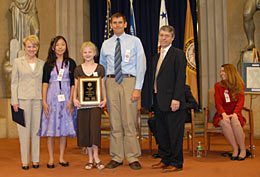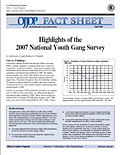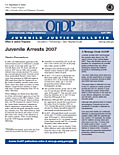

The Missing Children's Day 2009 logo
The Department of Justice (DOJ) commemorated the 26th annual National Missing Children's Day on May 21, 2009, with a ceremony at DOJ's Great Hall in Washington, DC, that honored missing children and recognized the extraordinary efforts made by law enforcement personnel and citizens to protect children from harm. Deputy Attorney General David W. Ogden was the main speaker and Office of Justice Programs Acting Assistant Attorney General Laurie O. Robinson presided over the ceremony.
In her opening comments, Acting Assistant Attorney General Robinson commended the exceptional efforts of the day's award recipients who "acted quickly and with a cool head to remove children from danger." The ceremony was attended by families of missing and abducted children, law enforcement personnel, and missing children's advocates.
Twenty-six years ago, President Ronald W. Reagan proclaimed May 25 as National Missing Children's Day in memory of Etan Patz, a 6-year-old boy who disappeared from a New York City street corner on that day in 1979. Missing Children's Day honors his memory and the memory of children who are still missing, celebrates the stories of recovery, and pays tribute to the exemplary efforts of agencies, organizations, and individuals engaged in protecting children.
Deputy Attorney General Ogden announced that the Department is awarding $50 million in American Recovery and Reinvestment Act funds to support OJJDP's Internet Crimes Against Children (ICAC) program. More than $41 million is being awarded to ICAC task forces nationwide to help law enforcement agencies develop an effective response to sexual predators who target children via the Internet and other electronic devices. In addition to these grants, the Department will award more than $8 million for training and technical assistance, research, and communication and data infrastructure to support the ICAC program.
In his remarks, Deputy Attorney General Ogden praised those in the audience for their dedication to children and families.
Because of you, countless children have been saved, and because of you, countless parents have been saved the heartache of a child who has been abducted. . . . But Missing Children's Day is just one day. For those gathered here, your work continues every day.
Deputy Attorney General Ogden presented awards to recognize the outstanding efforts of law enforcement personnel and citizens who have made a difference in recovering abducted children and protecting children from exploitation. The awards and recipients included:
- Special Agent Mike Bentolila, Immigration and Customs Enforcement; Special Agents Alexis Carpinteri and Michael D. Leverock, Federal Bureau of Investigation (FBI); Detective Jennifer Montgomery, Broward County (FL) Sheriff's Office; and Assistant U.S. Attorney Brent Tantillo, DOJ, Project Safe Childhood. Each received the Attorney General's Special Commendation Award for their successful prosecution of a Florida swim coach who downloaded and distributed child pornography and had sexual contact with at least five boys whom he coached.
- Special Agent Greg Ryman from the FBI's Innocence Lost Task Force in Washington, DC, received the Missing Children's Day Law Enforcement Award for his innovative efforts in developing ChildFinder, an automated computer program that analyzes erotic service advertisements in real time. ChildFinder assisted in the prosecution of an offender responsible for trafficking a 15-year-old girl and other victims of prostitution.
- Julie Mosbacher, a registered nurse from Cody, WY, was presented with the Missing Children's Day Citizen Award for her intuitive actions that led police to a double-homicide suspect accompanied by a small child in the emergency room. The suspect was arrested by police and the child was recovered safely.
- Detective Neil Spector of the St. Lucie County Sheriff's Office in Fort Pierce, FL, received the Missing Children's Day Child Protection Award for his development of an undercover online investigation that led to the prosecution of a Massachusetts resident and a New Hampshire resident for sexually abusing children and other charges.
- Dakhota-Rae Brown, a 5th grader from Henderson Elementary School in Cheyenne, WY, won the 10th Annual National Missing Children's Day Poster Contest. Her artwork will be used as the basis for the logo design of next year's Missing Children's Day ceremony.
Ernie Allen, President and CEO of the National Center for Missing & Exploited Children (NCMEC), described the "incremental revolution of change" that has occurred within the missing and exploited children's movement during the past 30 years, often in response to tragic abductions and murders of children. In 1979, there were no advocacy organizations or channels through which parents and investigators could raise public awareness when a child was missing, and law enforcement agencies did not communicate or collaborate on investigations, he said. Beginning with the passage of the Missing Children Act in 1982, the establishment of Missing Children's Day in 1983, the creation of NCMEC in 1984, and countless other programs and organizations, public awareness of the issue has increased and law enforcement agencies, advocacy organizations, and government agencies now work together when children are reported missing.
Prior to 1989, the police would say the child probably just ran away. . . . Progress has happened because of the people in this room and because of the organizations working together, both private and public. We have come light years. We are doing a better job.
Erin Runnion, founder and director of the Joyful Child Foundation, also spoke, sharing her perspective as the mother of a missing child and an advocate. Runnion's 5-year-old daughter Samantha was abducted and murdered in 2002. Runnion emphasized the need to educate children against the danger of abduction and to fight back if threatened.
I don't want to scare people, especially children. I want them to be brave so that they can meet any situation. . . . We can't protect every child, but for every child that is returned home safely there is a lifetime of countless joy.
The ceremony began and concluded with performances by the Benjamin Orr Elementary School Choir of Washington, DC. The Office of Justice Programs has had a relationship with the Orr School since 1991 as part of DOJ's volunteer outreach program. A full photo gallery of the day's events is available below. A gallery of the winning artwork from each state is available at: www.ojjdp.ncjrs.gov/programs/postercontest/2009gallery.html.
 Deputy Attorney General Ogden; Ernie Allen, President and CEO of the National Center for Missing & Exploited Children; and Erin Runnion, founder and director of the Joyful Child Foundation.
Deputy Attorney General Ogden; Ernie Allen, President and CEO of the National Center for Missing & Exploited Children; and Erin Runnion, founder and director of the Joyful Child Foundation. |
||
 Acting Assistant Attorney General Laurie O. Robinson presiding over the Missing Children's Day ceremony. |
 Erin Runnion, founder and director of the Joyful Child Foundation, speaking during the Missing Children's Day event. |
|
 2009 Attorney General's Special Commendation Award: (l. to r.) Deputy Attorney General Ogden; Assistant U.S. Attorney Brent Tantillo, DOJ, Project Safe Childhood; Special Agent Michael Leverock, FBI; Special Agent Alexis Carpinteri, FBI; Special Agent Mike Bentolila, Immigration and Customs Enforcement; Detective Jennifer Montgomery, Broward County (FL) Sheriff's Office; Acting Assistant Attorney General Robinson. |
 The Law Enforcement Award: (l. to r.) Deputy Attorney General Ogden; Special Agent Greg Ryman (FBI); Acting Assistant Attorney General Robinson. |
|
 The Missing Children Citizen of the Year Protection Award: (l. to r.) Acting Assistant Attorney General Robinson, Julie Mosbacher, Deputy Attorney General Ogden. |
 The Child Protection Award: (l. to r.) Deputy Attorney General Ogden and Detective Neil Spector of the St. Lucie County Sheriff's Office in Fort Pierce, FL. |
|
 The Missing Children 2009 Art Contest Winner: (l. to r.) Acting Assistant Attorney General Robinson; Doyoun Park, last year's art contest winner; Dakhota-Rae Brown, this year's winner; Paul Hartigan, art teacher; Deputy Attorney General Ogden. |
 Dakhota-Rae Brown of Henderson Elementary School in Cheyenne, WY, with her winning entry in the 10th Annual National Missing Children's Day Poster Contest. A full gallery of the winning artwork from each State is available here. |
|
 From l. to r.: Dakhota-Rae Brown, the 2009 winner of the National Missing Children's Day Art Contest, and Doyoun Park, the 2008 winner of the National Missing Children's Day Art Contest. |
 Doyoun Park, Paul Hartigan, Dakhota-Rae Brown, Deputy Attorney General Ogden. |
|
 Ernie Allen, President and CEO of the National Center for Missing & Exploited Children. |
 The Missing Children's Day ceremony began and concluded with performances by the Benjamin Orr Elementary School Choir of Washington, DC. |
|

The Benjamin Orr Elementary School Choir performing at Missing Children's Day. |
 The Marine Corps' Jr. Reserve Officers Training Corps Color Guard from Crossland High School in Temple Hills, MD, presenting the flag during the Missing Children's Day ceremony. |
 The International Association of Chiefs of Police (IACP) conducted a pilot program April 27–29, 2009, entitled "Law Enforcement Responses to Adolescent Girls," a training course that educates law enforcement personnel on the best ways to approach and interact with adolescent girls during police calls. The pilot program, which was cosponsored by OJJDP and the Office of Justice Programs and held in Philadelphia, PA, attracted nearly 55 participants from the law enforcement community.
The International Association of Chiefs of Police (IACP) conducted a pilot program April 27–29, 2009, entitled "Law Enforcement Responses to Adolescent Girls," a training course that educates law enforcement personnel on the best ways to approach and interact with adolescent girls during police calls. The pilot program, which was cosponsored by OJJDP and the Office of Justice Programs and held in Philadelphia, PA, attracted nearly 55 participants from the law enforcement community.
The goals of the course are to—
- Explain trends in girls' behavior and how it differs from boys' behavior.
- Practice different ways to interpret teen girls' behavior and to assist officers in assessing and responding to situations.
- Explore communication strategies law enforcement officers can use to gather information, deescalate potential crisis situations, and enhance decisionmaking.
- Examine the alternative options to arresting girls that are available to law enforcement personnel.
IACP distributed a survey among its members asking what kind of training courses they would find most useful and a large number of respondents cited the need for additional information on dealing with adolescent girls. Members said that a high level of expertise is needed to interact effectively with this population and that increased information on proper techniques and procedures might reduce the arrest rates for teen girls. Research from OJJDP's Girls Study Group has shown that the increase in the arrest rates for girls during the last decade is in part attributable to a change in arrest policies that encourage officers to make an arrest during domestic disturbance calls.
The course is expected to be offered regularly through IACP starting in mid-June, once the results of the pilot course have been evaluated and the training has been modified accordingly. More information about the course will be available at that time.
For information about other IACP training courses, please visit the IACP training Web site. Please visit OJJDP's resource page on Girls' Delinquency for more information about OJJDP's efforts to address and reduce girls' delinquency.
 An assessment of AMBER Alert operations in Indian country has concluded that inadequacies in communications and information-management technology significantly hamper the ability of tribal law enforcement agencies to respond to reports of missing, abducted, and endangered children and other life-threatening emergencies.
An assessment of AMBER Alert operations in Indian country has concluded that inadequacies in communications and information-management technology significantly hamper the ability of tribal law enforcement agencies to respond to reports of missing, abducted, and endangered children and other life-threatening emergencies.
Team members evaluated the ability of 13 tribal agencies to effectively process emergency calls, dispatch and monitor first responders, track information, and support investigative efforts. Conducted by Fox Valley Technical College and FirstPic Consulting, the assessment team used a combination of agency self-assessments, onsite inspection, interviews, and public records.
The evaluation covered tribal communities in New Mexico, Arizona, Wyoming, Washington, Nebraska, Montana, Oklahoma, and North Carolina. The assessment produced the following findings:
- Most tribal communities are located in areas of limited infrastructure and the law enforcement agencies do not have the technology to provide communications coverage over all their areas of responsibility.
- Most of the agencies lack basic communications equipment such as base stations, mobile terminals, antennas, and adequate facilities to house their communications centers.
- Only 2 of the 13 tribal agencies possess the capability to handle multiple simultaneous emergency calls or operate a phone bank in the aftermath of a crisis event.
- Most agencies lack adequate data management capabilities.
- All the tribes rely on a neighboring sheriff's department or State police agency to receive and forward emergency calls from tribal residents, causing reporting delays.
- Many tribal members do not have telephones in their homes or rely on cellular phones in areas that do not support wireless call intake.
- Most agencies suffer from significant personnel shortages, frequent turnover, and a lack of training for call takers.
Every tribal law enforcement agency participating in the assessment identified the improvement of communications and information-management technology as the most important factor in expanding their capability to respond to emergencies in their communities. More than 90 percent of funds requested by tribal communities with an AMBER Alert program are for improvements in this area.
Comprehensive interviews with tribal law enforcement personnel identified the following areas as the most important first steps in addressing these challenges.
- Improve access to telephone communications for the public. Install call boxes, build cellular towers, and implement programs to encourage and assist in cell phone ownership.
- Build, replace, or improve existing facilities, antennas, communications towers, and other vital technology.
- Access and implement modern information-management and data-sharing programs that allow real-time access to Enhanced 911 (E-911), Computer-Assisted Dispatch, and other technologies call centers use to identify the exact location where the wireless call for assistance was placed.
Call-taker training also was cited as a significant need throughout Indian country. OJJDP has responded to this need by developing a program of instruction specially designed for emergency call takers in Indian country. The training program is scheduled to be launched in fall 2009.
Bilingual Training for U.S.-Mexico Border States Scheduled
In September, OJJDP in collaboration with Fox Valley Technical College will conduct bilingual training in El Paso, TX, for senior law enforcement professionals from the United States and Mexico to develop cooperative strategies, enhance working relationships, and improve the overall effort to recover missing, abducted, and endangered children in the U.S.-Mexico border region.
Participants will include the Governors of Texas, California, Arizona, and New Mexico (or their designees); the AMBER Alert coordinators from each of these States; government representatives from the six Mexican States that share the border with the United States; and a representative from the National Center for Missing & Exploited Children.
Simultaneous translation and written materials in English and Spanish will be provided. This bilingual effort is critical to child recovery efforts in the border region because of the differences in terminology used by law enforcement and government agencies in the United States and Mexico. Topics to be discussed during the training include legal issues between the United States and Mexico that impact missing children cases; child recovery efforts that are currently being implemented in Ciudad Juárez, Mexico; the launch of the AMBER Alert program in the State of Baja California, Mexico; and the importance of collaboration with the Governors' offices in addressing child abduction issues in the U.S.-Mexico border region.
Resources:
For additional information about AMBER Alert, please visit its Web site.
OJJDP's Statistical Briefing Book (SBB), an online tool featuring current statistics about juvenile crime and victimization, provides a wealth of information for practitioners, policymakers, the media, and the public. The site recently underwent several changes including a redesigned look and a more informative home page.
SBB includes a Frequently Asked Questions section, data analysis tools, and access to related publications. SBB is a primary source of information about the juvenile justice field in the United States and throughout the world. During fiscal year 2008, there were nearly 700,000 visits to SBB and more than 2.1 million page views on the site. The site is especially reliable because statistical data are continually updated, ensuring that users receive timely information.
SBB has recently been enhanced for easier, faster access to information. Direct links to several popular data analysis tools have been added. A new Did You Know? section offers new facts and information every time users visit the home page. The What's New section is now featured at the top of the page to facilitate user access to the most up-to-date information. Finally, the site has a new design and color scheme that coordinate with other components of OJJDP's Web resources.

The following are just a few examples of other recent SBB updates that are ensuring users have quick access to the most comprehensive, accurate, and up-to-date juvenile justice data available.
- Easy Access to FBI Arrest Statistics, has been updated to include data for 2006. Easy Access to FBI Arrest Statistics presents juvenile arrest statistics for 29 offense categories at the national, State, and county level. Users can select displays based on counts or rates for juveniles, adults, or all ages combined.
- The Frequently Asked Questions section has been updated for Law Enforcement and Juvenile Crime, Juvenile Population Characteristics, and Juveniles in Corrections.
- Juvenile Arrests 2007 summarizes 2007 juvenile crime and arrest data reported by local law enforcement agencies across the country and cited in the FBI report, Crime in the United States 2007. This annual OJJDP Bulletin characterizes the extent and nature of juvenile crime that comes to the attention of the justice system and allows readers to compare trends over time.
Users Praise Statistical Briefing Book
"The SBB is a great tool for faculty and students. The site is easy to navigate, and the information is timely and important. Also, the site provides us with the opportunity to examine data, develop our own tables, and try to determine what the trends are."
Alida V. Merlo, Ph.D.
Professor, Department of Criminology
Indiana University of Pennsylvania
Indiana, PA
"I use the SBB to find data for writing my papers for presentation and publication. The Frequently Asked Questions section is especially useful for class discussion and assignments. The data analysis tools are also a great way to engage students with the data and to teach them to recognize differences in data presentation."
Peter Benekos, Ph.D.
Professor, Department of Criminology
Mercyhurst College
Erie, PA

OJJDP's Internet Crimes Against Children (ICAC) task force program recently held a training conference and a forum for ICAC task force commanders.
The Silicon Valley Internet Crimes Against Children Conference was held May 13–15, 2009, in San Jose, CA. The 3-day training event included information sessions on the latest ICAC investigation methods, prosecution strategies, case studies, and the latest practices used by online offenders. The event was cosponsored by OJJDP, and was open to law enforcement and prosecution staff from across the United States.
On March 26–27, 2009, OJJDP sponsored the ICAC Commanders' Meeting in Huntsville, AL, a forum for ICAC grantees to share best practices and to receive up-to-date information on the ICAC program. The 2-day meeting included a question-and-answer session with OJJDP Acting Administrator Jeff Slowikowski on how Recovery Act funding will impact ICAC operations. The Recovery Act provides funding for hiring additional personnel for approximately 3 years, and the most commonly voiced concern was the ability to retain these officers once the funding period ends. Most ICAC task forces need additional personnel because of vacancies and hiring freezes in place in many law enforcement agencies nationwide.
OJJDP Deputy Administrator for Programs Marilyn Roberts also made remarks regarding the ICAC program in fiscal year 2009, provisions of the PROTECT Act (Prosecutorial Remedies and Other Tools to End the Exploitation of Children Today), and the role of OJJDP's ICAC Advisory Group.
All OJJDP publications may be viewed and downloaded on the publications section of the OJJDP Web site. Print publications also may be ordered online at the National Criminal Justice Reference Service (NCJRS) Web site.
Now Available
 Highlights of the 2007 National Youth Gang Survey (Fact Sheet)
Highlights of the 2007 National Youth Gang Survey (Fact Sheet)
Annually since 1995, OJJDP's National Youth Gang Center has conducted a systematic survey of law enforcement agencies across the United States regarding the presence and characteristics of local gang problems. This Fact Sheet summarizes the findings from the 2007 National Youth Gang Survey. Among other findings, the Fact Sheet reports that more than one-third of the jurisdictions in the survey population experienced gang problems—the highest annual estimate since before 2000.
Highlights of the 2007 National Youth Gang Survey may be ordered from the NCJRS Web site.
 Juvenile Arrests 2007 (Bulletin)
Juvenile Arrests 2007 (Bulletin)
This Bulletin summarizes the juvenile data cited in the FBI report Crime in the United States 2007. In 2007, law enforcement agencies in the United States made an estimated 2.18 million arrests of individuals younger than age 18. Overall, there were 2-percent fewer juvenile arrests in 2007 than in 2006, and juvenile violent crime arrests declined 3 percent, reversing a recent upward trend. The latest data show increases in some offense categories but declines in most, with most changes being less than 10 percent in either direction.
Juvenile Arrests 2007 can be ordered from the NCJRS Web site.
Coming Soon
OJJDP will soon release four new Fact Sheets based on the report Juvenile Court Statistics 2005.
Delinquency Cases in Juvenile Court, 2005 (Fact Sheet)
This Fact Sheet presents statistics on delinquency cases processed between 1985 and 2005 by U.S. courts with juvenile jurisdiction. The estimates are based on data from more than 2,100 courts with jurisdiction over 80 percent of the Nation's juvenile population (youth age 10 through the upper age of original juvenile court jurisdiction in each State).
Delinquency Cases Waived to Criminal Court, 2005 (Fact Sheet)
This Fact Sheet presents estimates of the number of cases transferred from juvenile court to criminal court through the judicial waiver mechanism between 1985 and 2005. The number of delinquency cases judicially waived peaked in 1994 at 13,000 cases. This represented an 80-percent increase over the number of cases waived in 1985 (7,200). Since 1994, however, the number of cases judicially waived declined 47 percent (6,900 cases in 2005).
Person Offense Cases in Juvenile Court, 2005 (Fact Sheet)
This Fact Sheet presents statistics on person offenses (assault, robbery, rape, and homicide) handled by juvenile courts between 1985 and 2005. In 2005, U.S. juvenile courts handled an estimated 429,500 delinquency cases in which the most serious charge was an offense against a person. The 2005 person offense caseload was 133 percent greater than in 1985. In 2005, person offenses accounted for 25 percent of the delinquency caseload, compared with 16 percent in 1985.
Juvenile Delinquency Probation Caseload, 2005 (Fact Sheet)
This Fact Sheet presents statistics on delinquency cases resulting in probation between 1985 and 2005. In 2005, courts with juvenile jurisdiction handled 1.7 million delinquency cases. Probation supervision was the most severe disposition in 33 percent of all delinquency cases. Between 1985 and 2005, the overall delinquency caseload increased 46 percent. The national estimates were generated using information contributed to the National Juvenile Court Data Archive.
 The Coordinating Council on Juvenile Justice and Delinquency Prevention's meetings are open to the public. The meeting schedule for 2009 is being developed and will be announced once the dates and location have been confirmed. For additional information on the Council, please visit its Web site.
The Coordinating Council on Juvenile Justice and Delinquency Prevention's meetings are open to the public. The meeting schedule for 2009 is being developed and will be announced once the dates and location have been confirmed. For additional information on the Council, please visit its Web site.
The Council is comprised of 18 members, including 9 ex officio members—the Attorney General; the Secretaries of the Departments of Justice, Education, Health and Human Services, Housing and Urban Development, and Labor; the Assistant Secretary of Immigration and Customs Enforcement in the Department of Homeland Security; the Director of the Office of National Drug Control Policy; and the Chief Executive Officer of the Corporation for National and Community Service. An additional nine members are juvenile justice practitioners appointed by the Speaker of the House of Representatives, the Senate Majority Leader, and the President of the United States.
 The Federal Advisory Committee on Juvenile Justice (FACJJ) held its 2009 Spring Meeting March 15–17 in Washington, DC. An orientation for new members on the first day included an ethics review presentation featuring remarks by Acting OJJDP Administrator Jeff Slowikowski. The open meeting, held March 16, focused on preparations for the 2009 annual report. The planning committee also met to discuss plans for the fall meeting, which will convene October 29–31 in Austin, TX. On March 17, FACJJ members participated in a site visit to a juvenile detention facility in the Washington, DC area. Committee members were invited to observe best practices in this well-respected facility.
The Federal Advisory Committee on Juvenile Justice (FACJJ) held its 2009 Spring Meeting March 15–17 in Washington, DC. An orientation for new members on the first day included an ethics review presentation featuring remarks by Acting OJJDP Administrator Jeff Slowikowski. The open meeting, held March 16, focused on preparations for the 2009 annual report. The planning committee also met to discuss plans for the fall meeting, which will convene October 29–31 in Austin, TX. On March 17, FACJJ members participated in a site visit to a juvenile detention facility in the Washington, DC area. Committee members were invited to observe best practices in this well-respected facility.
FACJJ's annual request for information was sent to the States and territories on February 9, 2009, and responses were due back May 29, 2009. This informal survey provides each State and territory the opportunity to express ideas, concerns, opinions, and recommendations on juvenile justice issues. The results are compiled in the FACJJ Annual Report. To read last year's survey responses, please see the FACJJ Annual Report.
FACJJ meetings are public and anyone may register to attend and observe. For additional information, visit FACJJ's Web site.